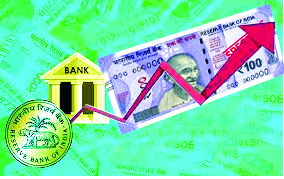Hargovind Sachdev
Indian Banks are on a roll this fiscal. The combined income of twelve public sector banks has crossed Rs.100,000 lac crores during the year ended 31.03.2023. State Bank of India alone has contributed half of the amount. The private sector banks have also performed well. The Non-Performing Assets have gone down to reasonable levels. The public sector banks have harnessed interbank mergers’ stress, and the entities work as homogenous units now.

Bank Income Built Around Repo Hikes is Not Sustainable
The spectacular performance has various reasons. Some call it a result of prudent lending, loan monitoring, and gatekeeping on vulnerable borrowers. Others explain the results of the imaginative follow-up of loans by banks. Others still credit the Regulator for the improved performance of banks. All stakeholders deserve kudos for strengthening the banks.
However, a deep analysis of banks’ stellar performance during the just-gone periods of high inflation and stiff cost of funds reveals an alarming story. The entire income has come from the modulation of Repo rates by the Reserve Bank of India, which repeatedly enhanced the interest rates. Banks passed on the increase in interest rates to borrowers on the day of the Monetary policy announcement. They earned ascending interest income on the same loans enhanced repeatedly by RBI. On their part, the banks took considerable time to provide higher interest on deposits. Existing depositors have yet to receive any hike. Only new deposits were rewarding after long time lags. Banks only paid enhanced interest to incremental deposits despite the loan portfolio yielding higher interest. The credit for the performance of banks goes to the Repo rate hike.
Banks’ sharing of reduced interest rates with their customers was also miserly. The cost of loans went up by over 4%, whereas the interest rates on deposits improved by an average of 2%. The Net Interest Margins shot up through Repo rate windfall, not quality lending.
The growth in the toplines of the banks had a similar windfall due to the non-availment of External Commercial Borrowings from overseas lenders as the interest rates of the ECB shot up, and hedging rates touched the sky.
A corporate loan has an average healthy life of four years. The companies surviving this period become big Corporates, whereas others enter the NPA portfolio of banks. During the last few years, aggressive lending still needed to be done due to Covid-19. Most PSUs availed of credit during this period. As such, very few NPAs have accrued. As such, the credit for low NPAs should go to the subdued demand for credit during Corona crisis.
MSME loans structured during the Corona are facing colossal distress, and RBI has declined requests of banks to restructure them again. The impact shall be visible this fiscal. The MUDRA loans lent aggressively during the last couple of years are also knocking at the doors of the NPA portfolio of banks.
Further, most loss-making banks have offset their accumulated losses against the Premium on Share Application Money in their balance sheets. Central Bank of India, UCO Bank and recently Punjab & Sind Bank wrote of total losses in one go, overnight. These banks have now declared profits that are hardly fractions of the written-down losses.
With the Reserve Bank of India avoiding the increase in the Repo rate in the last quarter of the previous financial year, the growth in the income of banks’ profits will go down. Already, April and May 2023 have been relatively low yielding for banks due to subdued credit offtake and the preponderance of a high-interest rate regime. The first quarter results for the period ending 30.06.2023 shall reflect reduced bank profits.
It is premature to celebrate the success of Indian banks because the real test of their decision-making will be visible this year as the pent-up demand for credit post-Corona fed by them starts yielding results. The long-term treasury investments by banks at frugal interest rates during the poor credit offtake will also begin to mature now, delivering low returns.
The withdrawal of Rs.2000 currency note shall bring in about Rs. 2.0 lac crores of deposits at existing high-interest rates for deposits. This liquidity will flood the banks by September 30, 2023, when the Rs.2000 currency notes eclipse into history. Acumen to invest this bonanza in safe and high-yielding assets at the earliest shall make the difference between winner and loser banks.



